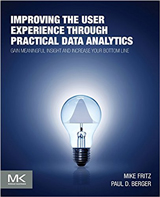[greybox]
 A review of
A review of
Improving the User Experience Through Practical Data Analytics
About this book
by Mike Fritz and Paul D. Berger
A good reference for Methods/How-To, UX Theory, Case Studies
Primary audience: Researchers who are new to the topic or have some experience with the topic
Writing style: Humorous, academic, matter-of-fact, mostly text
Morgan Kaufman, 2016, 368 pages, 11 chapters
Learn more about our review guidelines
[/greybox]
Improving the User Experience Through Practical Data Analytics offers up statistical data analysis lessons in bite-size chunks, illustrated with stories of fictional offices and the business problems they seek to solve through statistics. This isn’t the first book that focuses on teaching UX professionals data analytics skills to use in their work. However, what sets it apart is its conversational tone, a determined effort to not get too bogged down in the math, and inclusion of predictive marketing analytics that traditionally have not been taught for solving UX problems. The authors are both from the Boston area and met at Bentley University. Mike Fritz has been working in the field for 20 years and currently works for UserZoom. Paul Berger is a visiting scholar and professor of marketing at Bentley University and the program director for the Master’s of Science in Marketing Analytics program.
One of the defining aspects of this book, which makes the lessons a bit more stats-novice friendly, is the way that it’s organized. Each chapter (or lesson) starts with a fictional story of a user experience researcher interacting with colorful coworkers while trying to solve a business problem. Then it transitions into the discussion of a relevant statistical theory followed by instructions on how to conduct the analysis using both Excel and SPSS. After the lesson, we circle back to the fictional company and read a feel-good and affirming story of how the UX researcher uses the proposed solution to solve the company’s problems, impress skeptical coworkers, and basically save the day. Topics covered include T-tests, hypothesis testing, ANOVA, correlation analysis, and stepwise and logical regression.
So how user friendly is this book, really? The first chapter quickly covers a number of topics researchers who already know some stats may likely be familiar with: normal curve and probabilities, confidence intervals, and hypothesis testing. While the authors write that people already familiar might want to skip over this chapter, it is still heavy reading for someone with less grounding, and may move too quickly for the true beginner. Luckily there are exercises throughout the book to help you practice what you’ve learned.
After the first chapter, the pace slows down to smaller stats chunks, making it more digestible for someone who may be feeling a little overwhelmed.
You might be wondering, “What if I’m already a bit of an expert?” This book is really aimed at someone just learning this or someone looking for fresh ideas on how to apply the theory. A typical statistics theory section on any one of these subjects runs for about 5-10 pages. If you can write 5 pages on correlation analysis or regression yourself, you may walk away disappointed, or you may find yourself inspired by the way the book suggests introducing stats into common workplace conversations.
I had the opportunity to speak with the authors, who shared their inspiration for writing this book. They realized that there weren’t a lot of discussions or literature around using predictive analytics, such as correlation analysis and regression, in a UX context.
UX traditionally deals with smaller sample sizes, but the authors note that a lot of the analysis done with big data sets can and should be done with smaller sample sizes. While the book tackles some meaty topics, there’s a deliberate effort to limit time spent teaching the math that can often be handled through software. Berger described the model of the book as “minimize[ing] the math with no reduction in rigor,” adding that understanding “why” the analysis works is important.
Make no mistake – this is a statistics book targeted toward UX research. Its purpose is to teach those in the field how to use statistical analysis to strengthen research arguments that all so often turn political within corporations. Its title may do the book a disservice in that it makes the content sound drier than it is. The stories are memorable, which in turn makes the solutions, or the lessons, something that can be applied and retained. The details are so rich that I swear I heard a Boston accent coming from some of the characters! If you’ve always wanted to incorporate more quantitative, statistical analysis into your UX research, this is the book for you.
[bluebox]
Comparing Designs at Mademoiselle La La
During what is supposed to be the “final review,” tempers rise, and the two camps are getting increasingly agitated, extolling the sophistication of their design over the other. There are other subplots, because designer Josh Cheysak (Designer 1) is hoping his design is chosen to increase his chances of a raise, and designer Autumn Taylor (Designer 2) is hoping her design is chosen because she’s bucking for the Creative Director position. Nobody will budge. Think Boehner and Obama during the Great Government Shutdown of 2013.
Just as Cheysak is about to pour his Red Bull all over Taylor’s Moleskine sketchbook, you cautiously offer to perform a “head-to-head comparison survey with independent samples.”
A hush settles over the room. Taylor finally breaks the silence: “A what?”
You calmly explain that by running a survey featuring two different designs with two different groups of people, you may be able to determine differences between the two designs in terms of perceived sophistication and preference ratings. In other words, you can determine which one is best, based on user feedback. Trying not to sound too professorial, you add that “proper statistical analysis and good survey design can guard against obtaining misleading results.”
[/bluebox]
